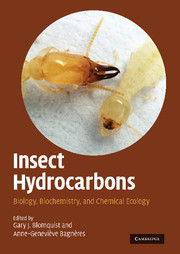Book contents
- Frontmatter
- Contents
- List of contributors
- Foreword
- Acknowledgments
- Part I Chemistry, Biochemistry, and Physiology
- Part II Chemical Communication
- 10 Perception and olfaction of cuticular compounds
- 11 Nestmate recognition in social insects and the role of hydrocarbons
- 12 Cuticular hydrocarbon cues in the formation and maintenance of insect social groups
- 13 Hydrocarbon profiles indicate fertility and dominance status in ant, bee, and wasp colonies
- 14 Chemical deception/mimicry using cuticular hydrocarbons
- 15 Behavioral and evolutionary roles of cuticular hydrocarbons in Diptera
- 16 Contact recognition pheromones in spiders and scorpions
- 17 Hydrocarbons as contact pheromones of longhorned beetles (Coleoptera: Cerambycidae)
- 18 Polyene hydrocarbons, epoxides, and related compounds as components of lepidopteran pheromone blends
- 19 Volatile hydrocarbon pheromones from beetles
- 20 Future directions in hydrocarbon research
- Index
15 - Behavioral and evolutionary roles of cuticular hydrocarbons in Diptera
from Part II - Chemical Communication
Published online by Cambridge University Press: 18 May 2010
- Frontmatter
- Contents
- List of contributors
- Foreword
- Acknowledgments
- Part I Chemistry, Biochemistry, and Physiology
- Part II Chemical Communication
- 10 Perception and olfaction of cuticular compounds
- 11 Nestmate recognition in social insects and the role of hydrocarbons
- 12 Cuticular hydrocarbon cues in the formation and maintenance of insect social groups
- 13 Hydrocarbon profiles indicate fertility and dominance status in ant, bee, and wasp colonies
- 14 Chemical deception/mimicry using cuticular hydrocarbons
- 15 Behavioral and evolutionary roles of cuticular hydrocarbons in Diptera
- 16 Contact recognition pheromones in spiders and scorpions
- 17 Hydrocarbons as contact pheromones of longhorned beetles (Coleoptera: Cerambycidae)
- 18 Polyene hydrocarbons, epoxides, and related compounds as components of lepidopteran pheromone blends
- 19 Volatile hydrocarbon pheromones from beetles
- 20 Future directions in hydrocarbon research
- Index
Summary
The behavioral role of dipteran cuticular hydrocarbons (CHCs) was first established nearly 40 years ago, in four articles on the behavior and chemistry of the housefly, Musca domestica, that came out of the USDA laboratory in Gainesville (Florida). Following Rogoff et al.(1964), Mayer and James (1971) showed that the non-polar lipid fraction of housefly feces was attractive to male houseflies; the active components – also found on the bodies of flies – were then identified as hydrocarbons (Silhacek et al., 1972b). Extracts from virgin females were attractive to males, whereas virgin male extracts were not (Silhacek et al., 1972a), indicating that these substances act as sex pheromones. Finally, Carlson et al.(1971) used both fractionation and synthetic hydrocarbons to demonstrate that (Z)-9-tricosene, the main compound found on the female cuticle, is a sex pheromone for male houseflies.
This model has come to dominate our understanding of chemical communication in Diptera, in particular those signals involved in courtship and mating. In fact, most dipteran species do not fit the Musca model. Although some species, like houseflies, show a marked qualitative sexual dimorphism, many species express only quantitative variation for compounds shared by both sexes (Bartelt et al., 1986; Jallon and David, 1987; Toolson and Kuper-Simbron, 1989; Byrne et al., 1995), while in other species adults of both sexes appear to be virtually identical (Stoffolano et al., 1997; Howard et al., 2003).
- Type
- Chapter
- Information
- Insect HydrocarbonsBiology, Biochemistry, and Chemical Ecology, pp. 325 - 343Publisher: Cambridge University PressPrint publication year: 2010
- 38
- Cited by



